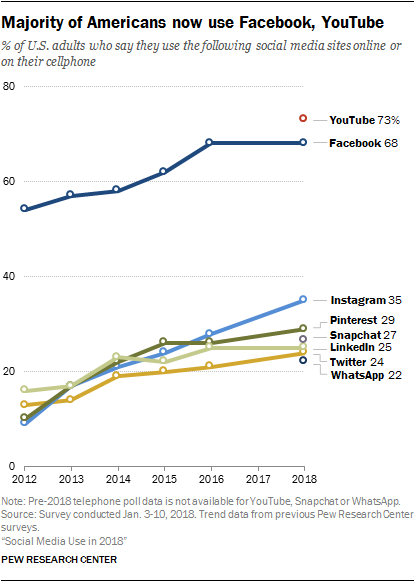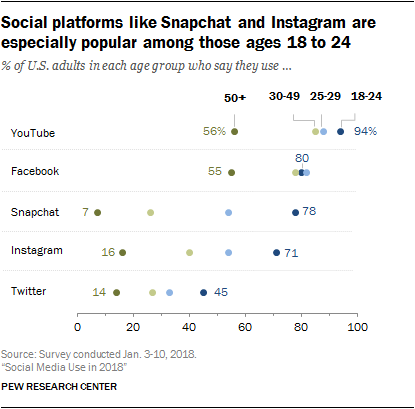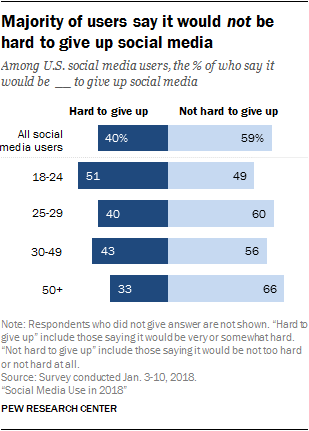Mar
2018
semicolon
https://www.facebook.com/TEDEducation/videos/1931106630235867/
++++++++++++++
more on proofreading in this iMS blog
Digital Literacy for St. Cloud State University
https://www.facebook.com/TEDEducation/videos/1931106630235867/
++++++++++++++
more on proofreading in this iMS blog
A majority of Americans use Facebook and YouTube, but young adults are especially heavy users of Snapchat and Instagram
http://www.pewinternet.org/2018/03/01/social-media-use-in-2018/
early 2018 is defined by a mix of long-standing trends and newly emerging narratives
Facebook and YouTube dominate this landscape, as notable majorities of U.S. adults use each of these sites. At the same time, younger Americans (especially those ages 18 to 24) stand out for embracing a variety of platforms and using them frequently. Some 78% of 18- to 24-year-olds use Snapchat, and a sizeable majority of these users (71%) visit the platform multiple times per day. Similarly, 71% of Americans in this age group now use Instagram and close to half (45%) are Twitter users

The video-sharing site YouTube – which contains many social elements, even if it is not a traditional social media platform – is now used by nearly three-quarters of U.S. adults and 94% of 18- to 24-year-olds.
a majority of users (59%) say it would not be hard to stop using these sites, including 29% who say it would not be hard at all to give up social media.


+++++++++++++++++++
more on social media use in this IMS blog
https://blog.stcloudstate.edu/ims?s=social+media+use
Third IMS vodcast: promotion of Kannan’s presentation on free tools
Kannan’s presentation on free tools available here:
Today’s vocast will be broadcasted live at:
Adobe Connect | Facebook Live | Twitter (#IMSvodcast) |
and will be archived at:
SCSU MediaSpace | YouTube (subscribe for the channel for future conversations)
Constructivism.
Student-centered learning theory and practice are based on the constructivist learning theory that emphasizes the learner’s critical role in constructing meaning from new information and prior experience.
+++++++++++++++
https://blog.stcloudstate.edu/ims/2018/02/12/first-ims-podcast-on-technology-in-education/
In computing, React (sometimes styled React.js or ReactJS) is a JavaScript library[2] for building user interfaces.
It is maintained by Facebook, Instagram and a community of individual developers and corporations.[3][4][5]
React allows developers to create large web-applications that use data and can change over time without reloading the page. It aims primarily to provide speed, simplicity, and scalability. React processes only user interfaces in applications. This corresponds to View in the Model-View-Controller (MVC) pattern, and can be used in combination with other JavaScript libraries or frameworks in MVC, such as AngularJS.[6]
https://en.wikipedia.org/wiki/React_(JavaScript_library)
++++++++++++++
more on Java script in this IMS blog
https://blog.stcloudstate.edu/ims?s=java+script
the Center for the Advanced Study of Technology Leadership in Education – CASTLE
If a school’s reputation and pride are built on decades or centuries of “this is how we’ve always done things here,” resistance from staff, parents, and alumni to significant changes may be fierce. In such institutions, heads of school may have to steer carefully between deeply ingrained habits and the need to modernize the information tools with which students and faculty work
Too often, when navigating faculty or parental resistance, school leaders and technology staff make reassurances that things will not have to change much in the classroom or that slow baby steps are OK. Unfortunately, this results in a different problem, which is that schools have now invested significant money, time, and energy into digital technologies but are using them sparingly and seeing little impact. In such schools, replicative uses of technology are quite common, but transformative uses that leverage the unique affordances of technology are quite rare.
many schools fail to proceed further because they don’t have a collective vision of what more transformative uses of technology might look like, nor do they have a shared understanding of and commitment to what it will take to get to such a place. As a result, faculty instruction and the learning experiences of students change little or not at all.
These schools have taken the time to involve all stakeholders—including students—in substantive conversations about what digital tools will allow them to do differently compared with previous analog practices. Their visions promote the potential of computing devices to facilitate all of those elements we now think of as essential 21st-century capacities: confidence, curiosity, enthusiasm, passion, critical thinking, problem-solving, and self-direction. Technology doesn’t simply support traditional teaching—it transforms it for deeper thinking and gives students more agency over their own learning.
Fear
Another prevalent issue preventing technology change in schools is fear—fear of change, of the unknown, of letting go of what we know best, of being learners again. But it’s also a fear of letting kids have wide access to the Internet with the possibility of cyberbullying, access to inappropriate material, and exposure to online predators or even excessive advertising. Fears, of course, need to be surfaced and addressed.
The fear drives some schools to ban cellphones, disallow students and faculty from using Facebook, and lock down Internet filters so tightly that useful websites are inaccessible. They prohibit the use of Twitter and YouTube, and they block blogs. Some educators see these types of responses as principled stands against the shortcomings and hassles of digital technologies. Others see them as rejections of the dehumanization of the education process by soulless machines. Often, however, it’s just schools clinging to the past and elevating what is comfortable or familiar over the potential of technology to help them better deliver on their school missions.
Heads of school don’t have to be skilled users themselves to be effective technology leaders, but they do have to exercise appropriate oversight and convey the message—repeatedly—that frequent, meaningful technology use in school is both important and expected. Nostalgia aside, there is no foreseeable future in which the primacy of printed text is not superseded by electronic text and multimedia. When nearly all information is digital or online, multi-modal and multimedia, accessed by mobile devices that fit in our pockets, the question should not be whether schools prepare students for a digital learning landscape, but rather how.
Control
Many educators aren’t necessarily afraid of technology, but they are so accustomed to heavily teacher-directed classrooms that they are leery about giving up control—and can’t see the value in doing so.
Although most of us recognize that mobile computers connected to the Internet may be the most powerful learning devices yet invented—and that youth are learning in powerful ways at home with these technologies—allowing students to have greater autonomy and ownership of the learning process can still seem daunting and questionable.
The “beyond” is particularly important. When we give students some voice in and choice about what and how they learn, we honor basic human needs for autonomy, we enhance students’ interest and engagement, and we truly actualize our missions of preparing lifelong learners.
The goal of instructional transformation is to empower students, not to disempower teachers. While instructor unfamiliarity with digital technologies, inquiry- or problem-based teaching techniques, or deeper learning strategies may result in some initial discomfort, these challenges can be overcome with robust support.
Support
A few workshops here and there rarely result in large-scale changes in implementation.
teacher-driven “unconferences” or “edcamps,” at which educators propose and facilitate discussion topics, can be powerful mechanisms for fostering professional dialogue and learning. Similarly, some schools offer voluntary “Tech Tuesdays” or “appy hours” to foster digital learning among interested faculty.
In addition to existing IT support, technology integration staff, or librarians/media specialists, some schools have student technology teams that are on call for assistance when needed.
A few middle schools and high schools go even further and assign teachers their own individual student technology mentors. These student-teacher pairings last all school year and comprise the first line of support for educators’ technology questions.
As teachers, heads of school, counselors, coaches, and librarians, we all now have the ability to participate in ongoing, virtual, global communities of practice.
Whether formal or informal, the focus of technology-related professional learning should be on student learning, not on the tools or devices. Independent school educators should always ask, “Technology for the purpose of what?” when considering the inclusion of digital technologies into learning activities. Technology never should be implemented just for technology’s sake.
++++++++++++
more on digital literacy for EDAD in this IMS blog
https://blog.stcloudstate.edu/ims?s=digital+literacy+edad
Dear Colleagues,
Software Carpentry (https://software-carpentry.org/about/) is coming to SCSU campus.
Want to learn basic computer programming skills specifically tailored for academia?
Please consider a FREE two-day workshop on either on Python or on R.
Python is a programming language that is simple, easy to learn for beginners and experienced programmers, and emphasizes readability. At the same time, it comes with lots of modules and packages to add to your programs when you need more sophistication. Whether you need to perform data analysis, graphing, or develop a network application, or just want to have a nice calculator that remembers all your formulas and constants, Python can do it with elegance. https://www.python.org/about/
R (RStudio) is a language and environment for statistical computing and graphics. R provides a wide variety of statistical and graphical techniques. R can produce well-designed publication-quality plots, including mathematical symbols and formulae. https://www.r-project.org/about.html
Both software packages are free and operate on MS Windows, MAC/Apple and GNU/Linux OS.
Besides seamless installation on your personal computer, you can access both software in SCSU computer labs or via SCSU AppsAnywhere.
https://appsanywhere.stcloudstate.edu/vpn/index.html
In an effort to accommodate as many faculty as possible, please indicate whether you want Python or R and check your availability using these Doodle polls:
Python
https://doodle.com/poll/fgf7mn5mze9knaps
R
https://doodle.com/poll/mzirw2nc4kfv9whs
Questions? Suggestions? Please do not hesitate to ask:
zliu@stcloudstate.edu
pmiltenoff@stcloudstate.edu
For more information:
https://blog.stcloudstate.edu/imshttps://blog.stcloudstate.edu/ims/2018/02/16/python-or-r-at-scsu/
https://www.facebook.com/InforMediaServices/
https://twitter.com/SCSUtechinstruc?lang=en #SoftwareCarpentry
February 12, 20185:03 AM ET
says David Greenfield, a psychologist and assistant clinical professor of psychiatry at the University of Connecticut:When we hear a ding or little ditty alerting us to a new text, email or Facebook post, cells in our brains likely release dopamine — one of the chemical transmitters in the brain’s reward circuitry. That dopamine makes us feel pleasure
“It’s a spectrum disorder,” says Dr. Anna Lembke, a psychiatrist at Stanford University, who studies addiction. “There are mild, moderate and extreme forms.” And for many people, there’s no problem at all.
Signs you might be experiencing problematic use, Lembke says, include these:
Consider a digital detox one day a week
Tiffany Shlain, a San Francisco Bay Area filmmaker, and her family power down all their devices every Friday evening, for a 24-hour period.
“It’s something we look forward to each week,” Shlain says. She and her husband, Ken Goldberg, a professor in the field of robotics at the University of California, Berkeley, are very tech savvy.
A recent study of high school students, published in the journal Emotion, found that too much time spent on digital devices is linked to lower self-esteem and a decrease in well-being.
+++++++++++
more on contemplative computing in this IMS blog
https://blog.stcloudstate.edu/ims?s=contemplative+computing
archived session here: https://blog.stcloudstate.edu/ims/view-podcasts/
Every week, we will be presenting you in a short 5 min session with topics of your interest.
We will be providing you with information and giving you the podium to share your solutions.
This information will be broadcasted and archived via multiple channels:
The SCSU MediaSpace | On the Facebook IMS page | Twitter (#IMSvodcast) | YouTube
You can participate during the live session via
Adobe Connect: https://webmeeting.minnstate.edu/scsuteched,
Facebook and Twitter
Here is a Google form, where you can share your topics requests, issues and solutions.